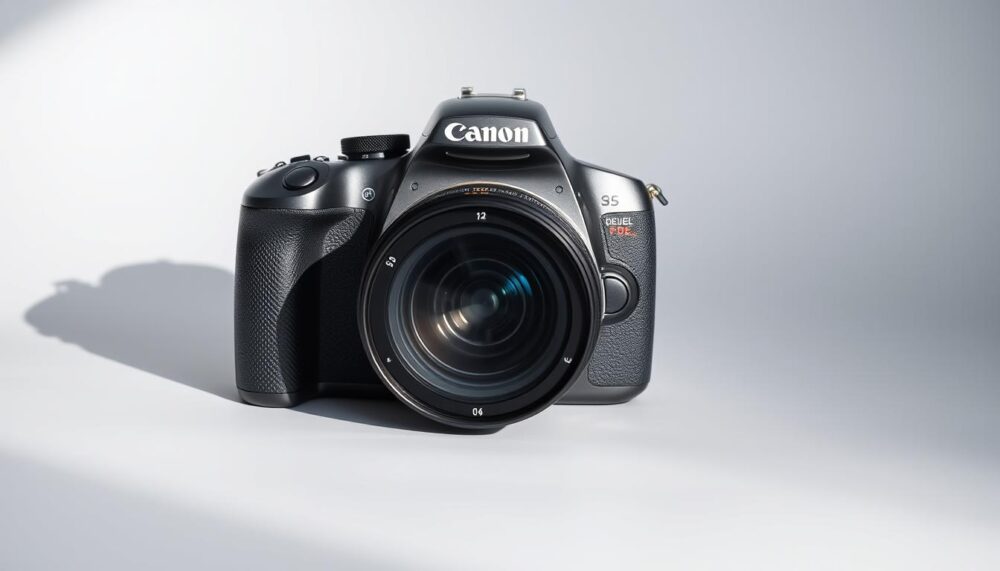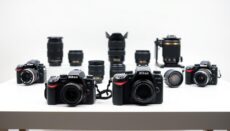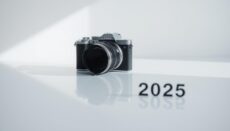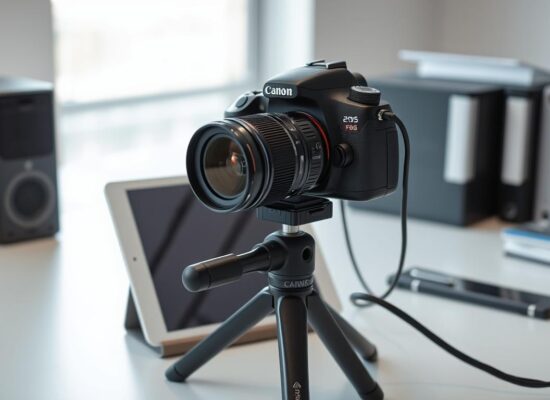In 2025, the Canon Rebel T7 remains a standout choice for photography enthusiasts. Despite its origins in 2018, this model continues to offer excellent value for beginners. Its 24.1MP APS-C sensor ensures sharp, detailed images, making it a reliable tool for learning the craft.
As an entry-level DSLR, the Rebel T7 stands out in a market dominated by mirrorless cameras. Its compatibility with EF/EF-S lenses provides flexibility, while its £400 price point makes it accessible. For those starting their photography journey, this device is a practical first step.
However, it’s worth noting its limitations. The lack of 4K video and a fixed screen may deter some users. Yet, for beginners, it serves as a transitional product before upgrading to more advanced systems. The Canon EOS range offers a seamless progression for growing skills.
Key Takeaways
- The Canon Rebel T7 is a budget-friendly DSLR ideal for beginners.
- Features a 24.1MP APS-C sensor for high-quality images.
- Compatible with EF/EF-S lenses for added versatility.
- Priced at £400, it’s an affordable entry into photography.
- Lacks 4K video and has a fixed screen, setting realistic expectations.
- Acts as a stepping stone before transitioning to mirrorless cameras.
Introduction to the Latest Canon Rebel Camera
Photography enthusiasts still turn to the Canon EOS Rebel T7 for its reliability and simplicity. Launched in 2018, this model remains a cornerstone in Canon’s 38-year EOS legacy. It’s a testament to how well-designed tools can stand the test of time.
For beginners, the Rebel T7 is an ideal starting point. Its user-friendly interface and compatibility with EF/EF-S lenses make it perfect for photography students and family users alike. Even in 2025, it continues to offer exceptional value for those exploring the craft.
Historically, the Rebel T7 marks a significant moment in Canon’s transition timeline. As one of the last DSLR models before the rise of mirrorless dominance, it bridges the gap between traditional and modern photography. Its 500-shot battery life is a standout feature, ensuring users can shoot for extended periods without interruption.
While newer mirrorless options like the EOS R50 and R100 offer advanced features, the Rebel T7’s simplicity and affordability keep it relevant. It’s a reminder that sometimes, the best tools are those that focus on the essentials.
- Part of Canon’s 38-year EOS legacy, the Rebel T7 remains a trusted choice.
- Perfect for beginners, students, and family users due to its ease of use.
- Represents a pivotal moment in Canon’s shift from DSLR to mirrorless systems.
- Boasts a 500-shot battery life, ideal for extended photography sessions.
- Competes with newer models by offering simplicity and affordability.
What Is the Latest Canon Rebel Camera?
For those seeking a reliable DSLR, the Canon EOS Rebel stands out. Its 24.1MP APS-C CMOS sensor ensures sharp, detailed photos, while the DIGIC 4+ processor enhances image quality. This combination makes it a solid choice for beginners and enthusiasts alike.
One of the standout features is the optical viewfinder. Unlike mirrorless alternatives, it provides a traditional shooting experience. This is ideal for those who prefer a more tactile approach to photography. However, the 3 fps continuous shooting speed may feel limiting for action shots.
The included 18-55mm f/3.5-5.6 IS II kit lens adds versatility. It’s perfect for everyday use, from portraits to landscapes. Additionally, Wi-Fi and NFC connectivity make transferring files effortless. This feature is particularly useful for sharing photos on the go.
- 24.1MP APS-C CMOS sensor for high-resolution images.
- Optical viewfinder offers a classic shooting experience.
- 3 fps continuous shooting may not suit fast-paced scenarios.
- Includes an 18-55mm f/3.5-5.6 IS II kit lens for versatility.
- Wi-Fi and NFC connectivity for easy file sharing.
For a deeper dive into its capabilities, check out this detailed review. The Canon EOS Rebel remains a reliable option for those exploring DSLRs in 2025.
Key Features of the Canon Rebel 2025 Model
Exploring the key features of the 2025 model reveals its strengths and limitations. While it retains the classic DSLR design, it introduces subtle improvements that cater to beginners and enthusiasts alike. Let’s delve into its core functionalities to understand its value proposition.
Sensor and Image Quality
The 24.1MP APS-C CMOS sensor ensures sharp, detailed images, making it a reliable choice for everyday photography. Its ability to handle various lighting conditions enhances its versatility. However, compared to newer mirrorless options, the sensor’s performance in low light shows minor limitations.
Autofocus System
The contrast-based autofocus system is straightforward but occasionally exhibits “hunting” behaviour, especially in low-contrast scenarios. While it’s sufficient for static subjects, fast-moving scenes may challenge its capabilities. This highlights the gap between traditional DSLRs and advanced mirrorless systems.
Video Capabilities
For video enthusiasts, the model maxes out at 1080p/30fps, which falls short of modern standards. The lack of 4K recording may deter content creators and vlogging professionals. Additionally, the absence of a mic input and in-body stabilisation limits its appeal for serious videography.
To achieve stable footage, using a tripod is highly recommended. When compared to the EOS R50, which offers 4K recording and a flip screen, the 2025 model feels outdated. However, for casual users, it remains a functional option.
Design and Build Quality
The design and build quality of the Canon Rebel 2025 model reflect its focus on accessibility and practicality. Its polycarbonate body ensures lightweight durability, weighing just 475g. This makes it easy to carry during extended shooting sessions, ideal for beginners and hobbyists.
Handling the device is comfortable, thanks to its ergonomic grip design from 2018. The layout of buttons and dials is intuitive, though it lacks the streamlined efficiency of modern mirrorless cameras. For those transitioning from smartphones, the tactile experience feels familiar yet professional.
One notable limitation is the absence of weather sealing. This restricts its use in harsh environments, such as rainy or dusty conditions. However, for indoor or casual outdoor photography, it remains a reliable choice.
Screen visibility is another aspect worth considering. The fixed LCD performs adequately in most settings but struggles under bright sunlight. This is a common issue among entry-level products, and users may need to rely on the optical viewfinder in such scenarios.
| Feature | Canon Rebel 2025 | Modern Mirrorless Cameras |
|---|---|---|
| Body Material | Polycarbonate | Magnesium Alloy |
| Weight | 475g | 400-450g |
| Weather Sealing | No | Yes |
| Screen Visibility | Fixed LCD | Articulating Touchscreen |
Despite its limitations, the Canon Rebel 2025 offers excellent value for its price. Its design prioritises simplicity and ease of use, making it a solid entry point for aspiring photographers.
Performance in Different Photography Scenarios
Different photography scenarios demand specific features to achieve optimal results. Whether capturing portraits, landscapes, or fast-moving subjects, understanding a camera’s strengths and limitations is essential. Let’s explore how this model performs across these environments.
Portrait Photography
For portraits, the 24.1MP APS-C sensor delivers sharp, detailed images with natural skin tones. The 9-point autofocus system works well for static subjects, ensuring clarity in every shot. However, in low-light conditions, the system may struggle slightly, requiring manual adjustments for precision.
Landscape Photography
Landscapes benefit from the sensor’s ability to capture vibrant colours and intricate details. Using a wide-angle lens enhances the depth and perspective of scenic shots. While the fixed LCD screen can be limiting for creative angles, the optical viewfinder compensates by providing a clear, unobstructed view.
Action and Wildlife Photography
Capturing fast-moving subjects, such as birds in flight, presents challenges. The 3fps burst rate is too slow for dynamic scenes, often missing critical moments. Pre-focusing techniques can improve results, but the 9-point autofocus system struggles with tracking moving subjects effectively.
For better performance, pairing the camera with a 55-250mm f/4-5.6 IS STM telephoto lens is recommended. This combination enhances reach and stability, ideal for wildlife photography. However, compared to advanced models like the EOS R7, which offers a 15fps burst rate, this model feels limited.
| Scenario | Strengths | Limitations |
|---|---|---|
| Portrait | Sharp, detailed images | Low-light AF struggles |
| Landscape | Vibrant colours, intricate details | Fixed LCD screen |
| Action/Wildlife | Telephoto lens compatibility | Slow burst rate, limited AF tracking |
“Understanding a camera’s capabilities in different scenarios helps photographers make informed decisions.”
While this model serves as an excellent entry-level option, its limitations in fast-paced environments highlight the need for more advanced systems. For those prioritising action or wildlife photography, exploring mirrorless alternatives may be worthwhile.
Image and Video Quality
Evaluating the image quality and video capabilities of this model reveals its strengths and limitations. JPEGs are optimised for social media, ensuring quick sharing without compromising detail. However, 1080p footage can exhibit moiré patterns in fine textures, which may affect content creators focusing on intricate details.
Colour reproduction varies across lighting conditions. In natural light, hues appear vibrant and true to life. Under artificial lighting, slight shifts in tone may occur, requiring minor adjustments during post-processing. This flexibility makes it suitable for hybrid shooters who balance photography and videography.
Compression artifacts are noticeable in video footage, particularly in high-motion scenes. While this doesn’t detract from casual use, professionals may find it limiting. Comparing detail retention to smartphone computational photography, the model holds its ground but lacks the advanced processing of modern devices.
- Colour accuracy excels in natural light but may shift under artificial lighting.
- Compression artifacts are present in high-motion video scenes.
- Detail retention is competitive but falls short of smartphone computational enhancements.
For flat-looking footage, grading tips include increasing contrast and saturation slightly. This enhances visual appeal without over-processing. Optimal exposure settings for hybrid shooters involve balancing ISO, aperture, and shutter speed to maintain clarity in both stills and videos.
Overall, the resolution and quality of this model cater well to beginners and casual users. While it may not meet the demands of advanced creators, it remains a reliable choice for everyday photography and videography.
Lens Compatibility and Options
Lens compatibility plays a crucial role in maximising the potential of any camera. The Canon EOS Rebel 2025 uses the EF/EF-S mount, providing access to a vast ecosystem of lenses. This flexibility allows photographers to choose from a wide range of options, whether shooting portraits, landscapes, or action scenes.
One standout feature is the ability to use both EF and EF-S lenses. EF lenses are compatible with full-frame cameras, while EF-S lenses are designed for APS-C sensors like the one in this model. This dual compatibility ensures users can build a versatile kit tailored to their needs.
Third-party options from brands like Sigma and Tamron further expand the possibilities. For example, the Sigma 17-50mm f/2.8 offers excellent sharpness and low-light performance, making it a popular choice for enthusiasts. Similarly, the Canon EF 50mm f/1.8 is a budget-friendly prime lens ideal for portraits and low-light photography.
- Access to the full EF lens ecosystem for maximum versatility.
- Third-party options like Sigma and Tamron provide additional flexibility.
- Budget-friendly prime lenses, such as the 50mm f/1.8, are perfect for specific genres.
- Crop factor implications mean EF-S lenses are optimised for APS-C sensors.
- Compared to the RF mount on mirrorless bodies, EF/EF-S offers broader compatibility.
Understanding the crop factor is essential when selecting lenses. APS-C sensors have a 1.6x crop, meaning a 50mm lens behaves like an 80mm lens. This is particularly useful for telephoto shots but may limit wide-angle options. For those transitioning to mirrorless, the RF system offers advanced features but requires an adapter for EF/EF-S lenses.
Overall, the Canon EOS Rebel 2025’s lens compatibility ensures photographers can achieve professional results without breaking the bank. Whether using native or third-party lenses, this model provides a solid foundation for creative exploration.
Battery Life and Connectivity
Battery life and connectivity are essential factors for photographers relying on their DSLR cameras. The Canon Rebel 2025 model offers a respectable 500 shots per charge, making it suitable for day trips or extended sessions. However, compared to modern mirrorless counterparts, this performance may feel limited.
In real-world use, the battery endurance is adequate for casual shooting. For those planning longer outings, carrying a spare battery is advisable. Third-party options, such as those from Wasabi or Duracell, provide cost-effective alternatives without compromising quality.
Wireless connectivity is another highlight. Wi-Fi and NFC enable seamless mobile transfers, allowing users to share images instantly. While transfer speeds are reliable, they may not match the efficiency of newer mirrorless systems. For faster workflows, consider using a card reader.
To maximise battery life, enabling power-saving settings is recommended. Reducing screen brightness and disabling Wi-Fi when not in use can significantly extend shooting time. These small adjustments ensure the camera remains operational throughout the day.
| Feature | Canon Rebel 2025 | Mirrorless Counterparts |
|---|---|---|
| Battery Life | 500 shots | 600-800 shots |
| Wireless Transfer | Wi-Fi/NFC | Wi-Fi/Bluetooth |
| Third-Party Batteries | Available | Limited compatibility |
Over the years, the DSLR market has evolved, but the Canon Rebel 2025 remains a solid choice for its price. Its battery life and connectivity features cater well to beginners and hobbyists, ensuring a reliable experience for everyday photography.
User Interface and Ease of Use
Navigating the user interface of a DSLR can be daunting for beginners, but the Canon Rebel 2025 simplifies the process. Its fixed non-touch LCD, combined with an in-camera guide, ensures even first-time users can quickly get started. The menu system is intuitive, with clear labels and logical grouping of settings.
Physical controls are ergonomically designed, making them easy to access while shooting. The quick control wheel is a standout feature, allowing users to adjust settings swiftly without diving into menus. This is particularly useful for capturing fleeting moments.
Compared to the touchscreen interface on the EOS R50, the Rebel 2025 feels more traditional. While touchscreens offer faster navigation, the physical buttons provide tactile feedback, which many photographers prefer. For beginners, this setup reduces the learning curve.
Here are some recommended settings for first-time DSLR users:
- Set the mode dial to Auto for hassle-free shooting.
- Enable the in-camera guide for step-by-step assistance.
- Use the quick control wheel to adjust exposure settings on the fly.
Overall, the Canon Rebel 2025 strikes a balance between simplicity and functionality. Its user-friendly design makes it an excellent choice for those new to DSLRs, ensuring a smooth transition from point-and-shoot products.
Comparison with Previous Canon Rebel Models
Comparing the latest model to its predecessors highlights key advancements. The Canon EOS Rebel 2025 boasts a 24.1MP sensor, a significant upgrade from the T6’s 18MP. This improvement enhances detail resolution, making it a better choice for enthusiasts seeking sharper images.
Despite these upgrades, some limitations remain consistent across generations. Video capabilities, for instance, still max out at 1080p, lacking the 4K resolution found in newer mirrorless dslrs. This shared constraint may deter users prioritising videography.
Handling has seen subtle changes over the years. The 2025 model retains the ergonomic grip of its predecessors but introduces a more intuitive button layout. These tweaks improve usability, especially for those transitioning from older models.
For users considering an upgrade, mirrorless options like the EOS R50 offer advanced features such as 4K video and faster autofocus. However, the Rebel 2025 remains a solid choice for those invested in the EF/EF-S lens ecosystem.
- Resolution improved from 18MP to 24.1MP, enhancing detail capture.
- Shared video limitations persist, with no 4K recording capability.
- Handling refinements make the 2025 model more user-friendly.
- Mirrorless systems are recommended for users seeking advanced features.
- Positioned as a reliable option in Canon’s discontinued DSLR line.
Canon Rebel 2025 vs. Competing Cameras
Photographers often debate whether to stick with DSLRs or switch to mirrorless systems. The Canon Rebel 2025 offers a traditional DSLR experience, while models like the EOS R50 and EOS R100 represent the future of mirrorless innovation. Let’s explore how they compare.
Canon EOS R50
The EOS R50 is a compact mirrorless option designed for versatility. Its RF mount ensures compatibility with Canon’s latest lenses, offering future-proofing for enthusiasts. Compared to the Rebel 2025, it boasts faster autofocus and 4K video capabilities, making it ideal for hybrid shooters.
However, the R50’s smaller body may feel less ergonomic for those accustomed to DSLRs. Its battery life is also shorter, averaging around 400 shots per charge. For photographers prioritising video and portability, the R50 is a strong contender.
Canon EOS R100
Priced at £569, the EOS R100 kit includes a newer processor but compromises on build quality. Its RF mount ensures access to Canon’s expanding lens system, though the kit lens’s optical performance is comparable to the Rebel 2025’s offering.
Battery life is slightly better than the R50, with around 450 shots per charge. However, the R100’s fixed screen and limited controls may deter users seeking a more tactile experience. For those transitioning to mirrorless, it’s a budget-friendly entry point.
Here’s a quick comparison:
- Ergonomics: Rebel 2025 offers a more traditional DSLR feel, while R50 and R100 are compact but less tactile.
- Future-Proofing: RF mount on mirrorless models ensures compatibility with newer lenses.
- Battery Life: Rebel 2025 leads with 500 shots, followed by R100 (450) and R50 (400).
- Hybrid Use: R50 and R100 excel in video, while Rebel 2025 focuses on still photography.
For hybrid photo/video users, mirrorless options like the R50 and R100 are worth considering. However, the Rebel 2025 remains a reliable choice for those preferring the familiarity of a DSLR.
Pros and Cons of the Canon Rebel 2025
When considering the Canon Rebel 2025, it’s essential to weigh its strengths and weaknesses. This dslr remains a popular choice for traditionalists, offering a blend of affordability and functionality. However, its limitations may deter those seeking modern features.
One of the standout advantages is its budget-friendly price. At £400, it’s an accessible entry point for beginners. The extensive EF/EF-S lens ecosystem further enhances its appeal, allowing users to experiment with various photography styles without breaking the bank.
Despite these benefits, the camera shows its age. The lack of 4K video recording is a significant drawback for content creators. Additionally, its technology feels outdated compared to newer mirrorless models, which offer faster autofocus and advanced video capabilities.
Repair and service availability is another factor to consider. Canon has committed to supporting this model until 2025, ensuring users can maintain their dslr without hassle. However, beyond this date, finding parts may become challenging.
For those debating between new and used options, the market offers varied pricing. A new unit guarantees warranty and reliability, while used models can be found at lower costs. Collectors may also value this camera as one of the last traditional DSLRs, adding a unique appeal.
| Aspect | Pros | Cons |
|---|---|---|
| Price | Budget-friendly at £400 | Limited resale value |
| Lens Ecosystem | Extensive EF/EF-S compatibility | No RF mount support |
| Technology | Reliable for beginners | Outdated compared to mirrorless |
| Video Quality | 1080p recording | No 4K capability |
| Collectability | Last of its kind | Limited future support |
In summary, the Canon Rebel 2025 is a solid choice for those valuing simplicity and affordability. However, its limitations highlight the need for careful consideration, especially for users prioritising modern features and quality.
Is the Canon Rebel 2025 Worth the Investment?
Investing in a DSLR like the Canon Rebel 2025 requires careful consideration of its value. For beginners, it offers an affordable entry into the world of photography, but how does it stack up against modern alternatives?
Compared to smartphones, the Rebel 2025 provides superior image quality and manual controls. While smartphones excel in convenience, this canon camera allows users to explore creative techniques, such as adjusting aperture and shutter speed. For those serious about learning, it’s a worthwhile tool.
The learning curve is another factor to consider. Unlike smartphones, the Rebel 2025 requires time to master its settings. However, this process helps photographers develop a deeper understanding of photography fundamentals. It’s an excellent choice for hobbyists and students.
When comparing total system costs, the Rebel 2025 is more affordable than many mirrorless options. While mirrorless cameras offer advanced features, they often come with higher price tags. For those on a budget, this DSLR provides excellent value.
Ideal user profiles include beginners, students, and casual shooters. If you’re considering an upgrade from a smartphone or point-and-shoot camera, the Rebel 2025 is a logical step. However, professionals or hybrid shooters may prefer mirrorless alternatives.
For different budgets, here are some recommendations:
- Under £400: The Rebel 2025 with a kit lens is a solid choice.
- £500-£700: Consider entry-level mirrorless cameras like the EOS R50.
- Above £700: Explore advanced mirrorless systems for enhanced features.
In summary, the Canon Rebel 2025 is a valuable investment for beginners and hobbyists. Its affordability and educational benefits make it a standout option in the DSLR market.
Recommended Accessories for the Canon Rebel 2025
Enhancing your photography experience with the right accessories can make a significant difference. Whether you’re shooting portraits, landscapes, or events, having the right tools ensures you’re always prepared.
A 64GB SD card is essential for storing high-resolution images and videos. With ample storage, you won’t miss a shot during extended sessions. Pair this with extra LP-E10 batteries to keep your body powered throughout the day.
For stability, a sturdy tripod is a must. It’s perfect for long exposures, group shots, or capturing sharp images in low lighting. Look for lightweight yet durable options for easy transport.
Affordable EF prime lenses, like the 50mm f/1.8, are ideal for beginners. They offer excellent sharpness and low-light performance, making them versatile for various scenarios. Adding a flash unit can also elevate indoor photography, ensuring well-lit subjects in any setting.
When travelling, protective gear such as padded camera bags and lens filters safeguard your equipment. A cleaning kit is equally important, keeping your lens and sensor free from dust and smudges.
Finally, consider must-have storage solutions like external hard drives or cloud services. These ensure your work is backed up and easily accessible for editing or sharing.
| Accessory | Purpose | Recommendation |
|---|---|---|
| 64GB SD Card | Storage | High-speed, reliable brand |
| LP-E10 Batteries | Power | Carry at least two extras |
| Tripod | Stability | Lightweight and durable |
| EF Prime Lenses | Versatility | 50mm f/1.8 for starters |
| Flash Unit | Lighting | Compact and adjustable |
| Protective Gear | Safety | Padded bag, lens filters |
| Cleaning Kit | Maintenance | Microfiber cloth, blower |
| Storage Solutions | Backup | External drive or cloud |
Investing in these accessories ensures you get the most out of your Canon Rebel 2025. They not only enhance performance but also protect your gear for years of use.
Where to Buy the Canon Rebel 2025 in the UK
When looking to buy the Canon EOS Rebel 2025, UK shoppers have several options to consider. From authorised retailers to grey market sellers, understanding the differences can ensure a smooth purchase experience.
Authorised sellers, such as Amazon UK, offer body-only deals starting at £399. These retailers provide warranties and customer support, ensuring peace of mind. Grey market sellers, on the other hand, often lack warranty coverage, which can be a significant drawback.
Current bundle deals are worth exploring. Many trusted UK retailers include accessories like lenses, memory cards, or cases, adding value to your purchase. Seasonal sales, such as Black Friday or Boxing Day, often feature cashback offers, trimming prices by 5-10%.
Here’s a quick comparison of trusted retailers and their offerings:
| Retailer | Price | Bundle Inclusions |
|---|---|---|
| Amazon UK | £399 | Body-only |
| Jessops | £450 | Kit lens, memory card |
| Wex Photo Video | £470 | Kit lens, case, cleaning kit |
For those considering used options, prices vary based on condition and age. For example, a mint-condition Canon EOS R50 can be found for £500-£600. However, always verify the shutter count and overall condition before purchasing.
To ensure a seamless buying experience, check out this detailed guide on selecting the best Canon EOS camera for your needs. Whether you’re a beginner or a seasoned photographer, making an informed decision is key.
Conclusion
For beginners stepping into the world of photography, the Canon Rebel 2025 offers a solid foundation. Its user-friendly design and compatibility with EF/EF-S lenses make it an excellent choice for those starting their journey. However, its technological limitations, such as the lack of 4K video, highlight its position as an entry-level dslr.
Canon’s shift towards mirrorless systems is evident, and this model serves as a bridge between traditional and modern camera technology. While it may not meet the demands of advanced users, it remains a reliable tool for learning the craft.
For those considering this camera, hands-on testing is recommended. Understanding its strengths and limitations ensures it aligns with your needs. Whether you’re a hobbyist or a student, the Rebel 2025 delivers excellent quality for its price.
FAQ
What are the standout features of the Canon Rebel 2025 model?
The Canon Rebel 2025 boasts a high-resolution sensor, advanced autofocus system, and impressive video capabilities, making it a versatile choice for photographers and videographers alike.
How does the image quality compare to previous models?
The 2025 model delivers enhanced image quality with improved colour accuracy and dynamic range, thanks to its upgraded sensor and processing engine.
Is the Canon Rebel 2025 suitable for wildlife photography?
Absolutely! Its fast autofocus and burst shooting modes make it ideal for capturing fast-moving subjects like wildlife.
Can I use my existing Canon lenses with this camera?
Yes, the Canon Rebel 2025 is compatible with Canon’s EF and EF-S lenses, offering flexibility for photographers with existing gear.
How does it perform in low-light conditions?
With its improved sensor and noise reduction technology, the Canon Rebel 2025 excels in low-light scenarios, producing clean and detailed images.
What video features does it offer?
The camera supports 4K video recording, along with advanced autofocus tracking and stabilisation, making it a great choice for vlogging and filmmaking.
How does it compare to the Canon EOS R50 and R100?
While the EOS R50 and R100 are mirrorless options, the Canon Rebel 2025 offers a more traditional DSLR experience with similar performance and a wider lens compatibility range.
What accessories are recommended for this camera?
A sturdy tripod, additional batteries, and a quality lens kit are highly recommended to maximise the camera’s potential.
Where can I purchase the Canon Rebel 2025 in the UK?
You can find it at major electronics retailers, Canon’s official website, and trusted online stores like Amazon and Argos.
Is the Canon Rebel 2025 worth upgrading to?
If you’re looking for improved image quality, better autofocus, and enhanced video features, the Canon Rebel 2025 is a worthwhile upgrade.









